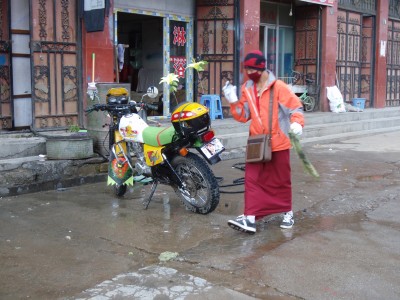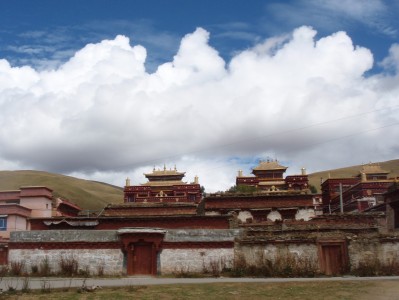
- Tibetan woman spinning prayer wheel in Litang
We have been traveling for two weeks. somehow it seems much longer. Chengdu and the Tibetan Plateau are very different places, in landscape and people. Chengdu is a very large city of Han Chinese, and the Himalayan west of Sichuan is sparsely populated with Tibetans. Many people think of the Tibetan people and the Tibetan Plateau as being only within the lines drawn by the Chinese government, the Tibetan Autonomous Region. Both the Plateau and the Tibetan people are spread over several other provinces. The government encourages Hans to move into Tibetan lands with various incentives, and by building new cities deep in formerly exclusive Tibetan lands. But the fingers of Himalayas we crossed to climb the Plateau, and the difficulty in building and maintaining roads, have kept this part of Tibetan land Tibetan.
We will now turn south, remaining on ridges of the Plateau for a few hundred kilometers, with at least one pass higher than any we have yet crossed, nearing 16,000 feet. Not far from here, the great rivers of SE Asia are given birth; the Yangtze and the Mekong are the two we will meet. We will cross the Yangtze as it turns north, and follow the Mekong south into Laos, Vietnam, Cambodia and Thailand. Here, these already powerful streams, are separated by just a few high ridges before becoming the two greatest rivers in this part of the world. Along their courses live one of the largest concentrations and most diverse collections of peoples on Earth. We will encounter many cultures and the landscapes that helped form them, and we will share what we learn with you.
These postings are a small part of the material we are gathering, and they will be expanded into a larger picture of the region, after we return home.
And now a brief look at Litang:

- Monk at the Litang Meat Market
Litang is one of the few cities in China with a majority Tibetan population. We were told in Chengdu, by a resident experienced China traveler, that we would see a more genuine view of the Tibetan people on the route we were taking than the throngs of tourists going to Lhasa. It does seem that we see few laowai (foreigners) here and we haven’t seen any touts (“Hello friend! Let me take you to a wonderful hotel!”)

- A Monk Detailing His Motorcycle
They are a rambunctious people, and demonstrative toward strangers. Their culture and religion seem more important to them than to most, and they seem eager to share it. We visited a chorten (stupa square) Baita Gongyuan, where a smiling man invited us to take a lap and spin the prayer wheels. There seems almost an element of play to the practice; Claire noticed the Tibetans were so fast that they lapped us.

- Turning Prayer Wheels
The public market is lively and filled with interesting fungus, vegetables, fruits and sides of yak, with men arguing over the value of various cuts. There are various fried breads and all manner of hand-made and manufactured things unknown in the West.
We have enjoyed walking the streets and interacting with the people, more than most Chinese cities, and I will miss it when we turn south toward Shangri-la, still many kilometers and mountains away.
Claire:
While we wait out the rain that has not yet materialized, we’ve spent some time getting to know Litang. I feel more comfortable now than when we first arrived; it’s like arriving in a new country. The people look different, act different and it takes some time to acclimate to the change in culture as well as in elevation.
I’ve been learning to speak a little more Mandarin and was even able to say: “We have friends who (do) Mahjongg, but we can’t.” But now, my limited Mandarin is useless here and I had a very funny exchange today with a friendly Tibetan woman who guessed, through graphic gestures, that I was looking for a toilet. She led me, arm in arm; she was going to the same place.

- Monastery
Today, we walked up the hill to the monastery through traditional Tibetan neighborhoods. The monastery reminded me of San Xavier del Bac because of all the intricate detail being put into the renovations. Huge murals filled the walls, yet looking at them up close, we could see how fine the painting was. That level of detail went all the way up, so high that no one could possibly appreciate it up close, yet there it was. I’m sure the artists who painted it appreciated it. The entry to the main hall was in the process of being carved and was not yet painted, yet it was just as beautiful as all the painted woodwork. While we were looking at the large Buddha, some Tibetans came in with young children and began the prostration ritual.


- Showing off for the Laowai

- They love their trucks, and decorate them.

- Decorating his stoves: winter is coming.

- At the market

- Monster scaring laowai

- Two young women enjoying the streets of Litang

Claire Rogers writes on cross-cultural adventure drawn from her travels across the Silk Road from Beijing to Istanbul, around Australia and of course, through Iceland–all by bike.
She’s currently traveling by tandem with her husband Bob, through southwest China, Laos, Vietnam, Cambodia and Thailand. Check out NewBohemians.net for more information on their travels.








